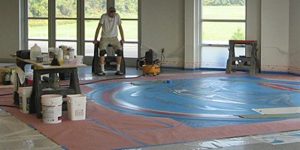A “punch list” is the final review of a project. It is usually completed by the project architect and is most often completed after the project has reached a milestone called “substantial completion.”
For a decorative concrete contractor, the punch list is probably the single largest money-losing piece of a project. In general, punch-list work is time-consuming and difficult to master. The needed repairs are usually small areas that have to be reworked and then blended to match the larger body of the project. On projects with color this can be extremely difficult.
I was once involved with a polished concrete project in a school where vandals came in after we had finished and, using an acid gel, added their particular version of graffiti to the polished concrete floors. Sections of the floor had to be reground to remove the etched writing. When these small sections (that totaled about 10 percent of the floor area) were recolored, they were slightly darker and had a little bit more clarity than the rest of the floor. As contractors we know that any time we regrind a floor, the clarity goes up.
The rest of the floor looked great and had already been approved by the architect and the customer, in this case the school district. But after the customer looked at the touched-up areas, the question they had was, “Why doesn’t the rest of the floor look as good as the repaired areas?”
In the end we had to regrind and color about 75 percent of the school in order to make the owner happy.
Now this is an extreme case, but it demonstrates the major problem with punch-list touch-ups.
As a consultant for retailers, I perform punch lists almost every week. The single largest recommendation that I can make to you contractors out there is to review your projects before you apply stain protection or sealer. Deal with any potential punch-list items at that time. After stain protection or sealer has been applied, it is extremely difficult to color or touch up floors.
Every contractor’s goal should be to attempt, on every job, to address all potential punch-list items before the owner or architect has an opportunity to walk the project. I suggest that this is a good way to encourage your crew leadership to raise the overall quality of your work.
Also, when it comes to punch-list projects, the review at the beginning of the project is just as important as the completion at the end. As the decorative concrete contractor, the responsibility for the look of the floor at its completion ultimately falls on you. The only problem with this is that you are working on a surface where someone else controls the quality. Routinely, contractors are held accountable for issues such as rough or sandy finishes, hand-troweled edges that slope or have chatter marks, poor work at column block-outs, significant elevation changes that result in areas where the grind looks different, scars from the power trowel, footprints, cracks, chips, pitting, delaminated surfaces, and on and on. These issues were not caused by the decorative concrete work, but as the finish contractor, you are expected to make them disappear. This is not an easy task. Most of the time repairing these types of issues is actually impossible. So how do you deal with them?
My suggestion is to walk the floor before the project is started. Actually take the time — or have your foremen or crew leaders take the time — to review the concrete before any work is started. Identify all of the potential issues that you can find. I know that some issues may not be exposed until you start work, but most are visible and relatively easy to find. Then get your customer or general contractor, walk the floor again and point out every one of these problems to them. Email the list of problems or deficiencies to the contractor or customer as soon as possible after the walk-through.
A lot of the issues that you find will go away with your regular scope of work, but if they do not, you will now have the grounds to get paid (via change orders) for the repairs instead of having the customer hold your feet to the fire and force you to repair someone else’s work.
To sum up, first, walk the project on the front end, recording any and all potential issues, and review them with your customer or general contractor before you start any work. Second, walk the project in its entirety before you apply stain protection or sealer and repair anything that you think might hit a punch-list review. If you will do these two things I believe that you will see your profitability go up and your project headaches go down.















